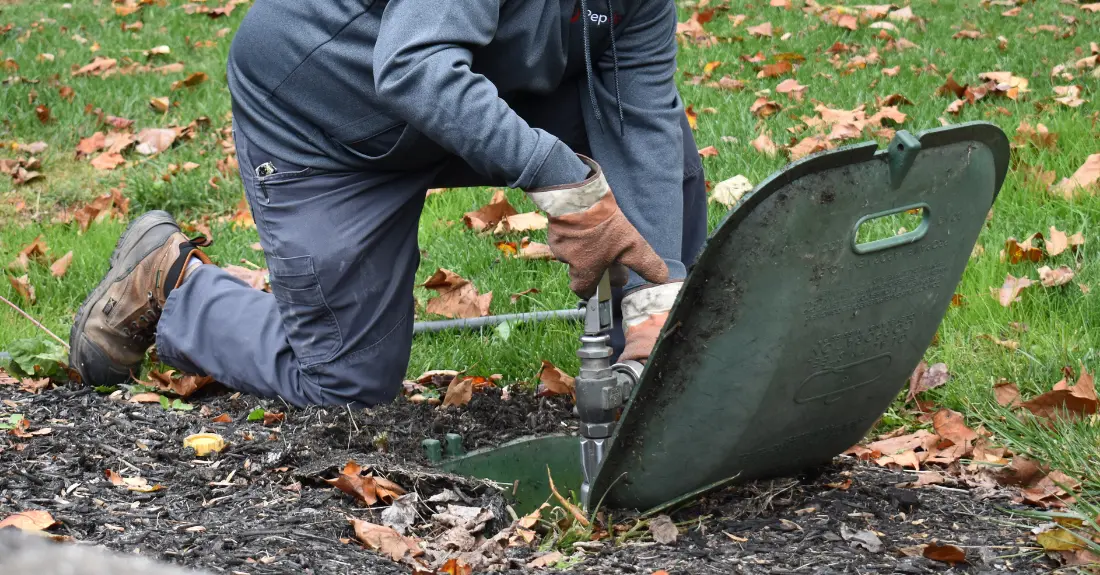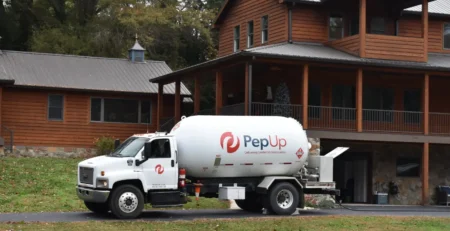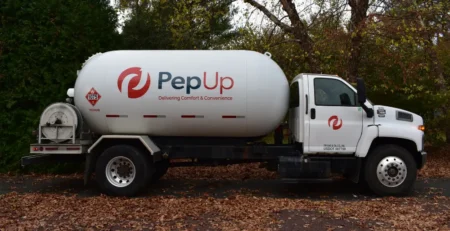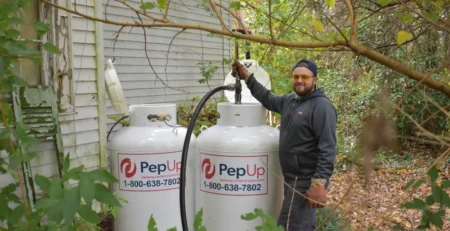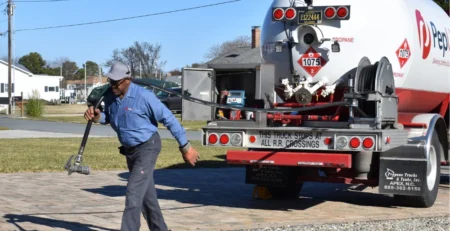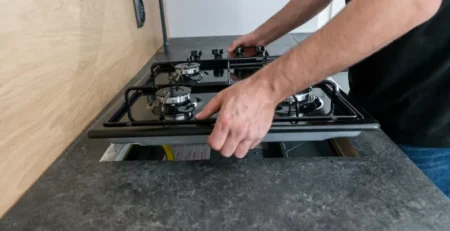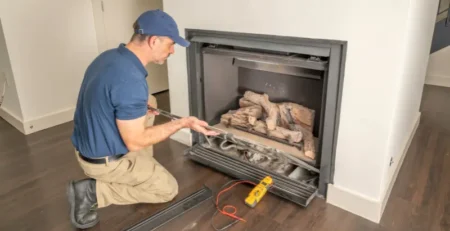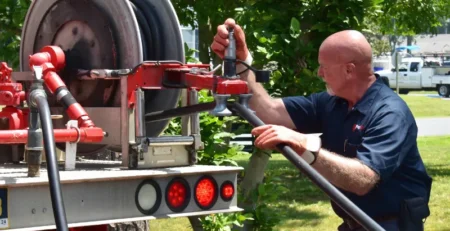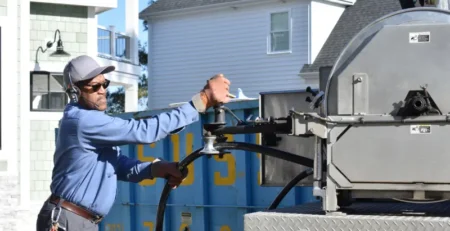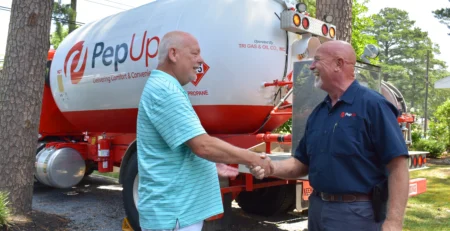Calculate your annual propane gas needs in Delaware
Propane gas is a popular fuel for the primary heating of homes in Delaware, Maryland, Virginia, and all over the PepUp service area. Our local propane delivery and service customers rely on our experienced team to keep their propane tanks from running out using our Automatic Delivery Service and “No Run Out” Guarantee.
Even when we’re making sure your propane tank doesn’t run out, it’s helpful to understand how much propane your home will use in a year. If you’re considering adding propane heating to your existing home, building a home and using propane heat and appliances, or even just budgeting for a relentlessly wet and cold Mid-Atlantic winter, PepUp is here to help. We’ve put together a few tips, a formula, and even a handy calculator tool for figuring up your home’s propane gas needs.
What is propane gas?
You may see or hear propane referred to as propane gas or LPG: Liquefied Petroleum Gas. LPG is usually a mixture of propane gas and butane, two liquid natural gas products that are mixed to deliver clean-burning and efficient fuel to meet home heating, cooking, and comfort needs.
Propane gas is compressed and stored as a liquid in tanks outside the home. Tanks usually range in size from 100 gallons to 1000 gallons, and can be placed above ground or below ground. The colorless, non-toxic propane is piped into the home. Propane is naturally almost odorless, so for safety, an odor is added to alert people to propane leaks, which can present a fire hazard if not addressed quickly.
Anytime you suspect a propane leak, call PepUp 24/7 for emergency propane service.
How can I plan for my home’s propane needs?
The amount of propane gas your home will use in a year depends on six (6) primary factors:
- What appliances use propane in your home
- The efficiency of those appliances
- The number of annual heating degree days (below 65 degrees) in your area
- Your home’s size and efficiency factors like insulation R-value
- The number of people living in your home
- Where you like to set the thermostat in the winter
Let’s break these factors down even further so you can take inventory of your home propane needs.
Home use planning: How much propane do I need?
Propane usage depends on the number of BTUs (British Thermal Units) you’ll need to power your home’s furnace and appliances. Propane gas provides 91,547 BTUs per gallon. Each of your propane appliances is labeled with an “input” BTUh (BTUs per hour) that can help you estimate propane usage for every hour that the appliance is running.
Did you know? Every new PepUp customer works with our Energy Specialists to determine their unique home propane needs. Hit the easy button and schedule a call to learn about your home’s propane needs.
Calculate Your Home Propane Needs: A Step-by-Step Guide and Calculator Tool
Use the steps below for a more accurate calculation of your home’s energy needs, in gallons of propane, each year. Or, skip ahead to use our calculator that can provide you with a rough estimate of your home’s energy needs each month, based on standard appliance energy usage.
Step 1: Determine how much energy your home appliances use
Use these average numbers to calculate propane usage if you don’t have easy access to your manufacturer-supplied propane usage information:
- Propane fireplace inserts used for supplemental heating will use about 50,000 BTUh.
- Traditional water heaters with a 30- to 40-gallon tank run on about 45,000 BTUh.
- Tankless water heaters use more propane when actively heating water than traditional water heaters, but don’t require constant heating to keep water hot.
- Their energy requirements range from 140,000 BTUh to 430,000 BTUh while actively running, depending on the temperature of the water entering the heater, the temperature set for heating, and the gallons per minute of flow. Your water heater settings and household usage will determine how much energy you’ll need for hot water.
- Gas-powered clothes dryers use about 35,000 BTUh.
- LPG gas ranges burn about 65,000 BTUh. A propane oven uses about 25,000 BTUh.
- Swimming pool heaters use a lot of energy, typically around 100,000 to 250,000 BTUh. Keep your pool covered in winter to conserve as much heat as possible.
Consider additional propane users inside and outside your home. Supplemental heaters, outdoor kitchens and fire pits, and standby generators will also need adequate propane and will affect your annual propane consumption.
Step 2: Estimate annual energy needs in gallons of propane
- Find the BTUh for all your home’s appliances, either using these averages or by looking on the appliance plate.
- Multiply BTUh by the average number of hours per day each appliance will run, calculating averages in daily usage from a typical day in each season of the year.
- Add up all your daily averages and multiply by 365 to find your annual BTUh usage.
- Take that total, and divide by 91,547 to convert your home’s annual propane gas energy needs to gallons of propane.
No time to do the calculations? Use the calculator below to estimate how much propane you’ll use each year, based on average appliance energy needs. Then, you’ll have a better idea what size propane tank you need and how frequently you’ll need propane delivery to keep your home fueled, all year long.
Propane Needs Calculator (Monthly)
| Appliance | Typical BTUh | Hours Used/Day |
|---|---|---|
| Furnace | 100,000 | |
| Water Heater | 45,000 | |
| Gas Fireplace | 50,000 | |
| Clothes Dryer | 35,000 | |
| Gas Range | 65,000 | |
| Oven | 25,000 |
Note: Actual propane use may vary based on appliance efficiency, climate, and usage habits.
PepUp is Here to Help!
If you’d rather work with a professional to determine your home’s energy needs, speak with a PepUp Energy Specialist about the average home propane use we see in the local area, or the estimate you determined by using the calculator. The details can come later, but knowing what size tank you’ll need and how often you’ll need propane delivered will help you plan for your energy budget and get your home propane addition or conversion project underway. Any questions? Just ask PepUp!
Frequently Asked Questions (FAQs) About Calculating Home Propane Needs
The calculator estimates your monthly propane usage based on the BTU ratings of your appliances and how many hours per day you use them. Enter your usage for each appliance and the number of days in the month to get an estimate in gallons. To find your annual usage estimate, simply multiply your monthly result by 12.
Note: this method does not take your location’s heating degree days into account, and won’t be as accurate as calculating monthly home heating needs based on your zip code location’s average HDDs. To enter your zip code and find your area’s average heating degree days, use the HUD Heating Degree Database. Then, you can use the calculator to determine the amount of propane you’ll need to run your heating system for an average month in your area.
Actual propane usage may vary depending on appliance efficiency, climate, insulation, and your personal usage habits. The calculator provides an estimate based on typical appliance BTU ratings.
One gallon of propane contains approximately 91,547 BTUs.

